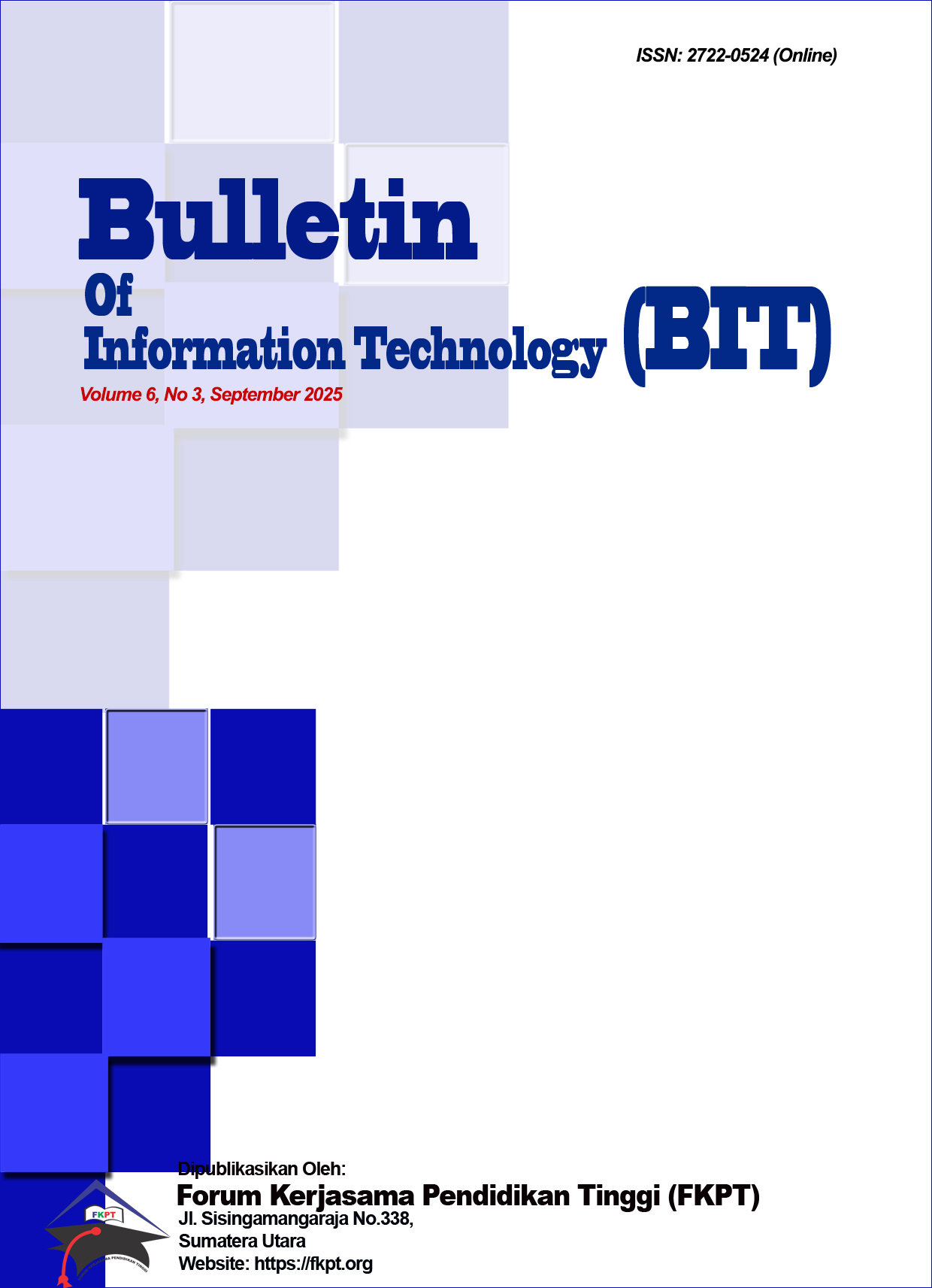Sistem Pemantauan Tanaman Dalam Pot Indoor Dengan Internet of Things
Abstract
This study discusses the design and implementation of an Internet of Things (IoT)-based indoor potted plant monitoring system, which aims to help users care for plants in a more effective and efficient manner. The system uses an ESP32 microcontroller connected to a DHT22 sensor to measure air temperature and humidity, soil moisture, an LDR to measure light intensity, and a TDS sensor to monitor nutrient levels in the water. Data collected from the sensors is transmitted directly via a WiFi connection to an MQTT broker, displayed on a Node-RED dashboard, and stored in Firebase for historical documentation purposes. This system has two operational modes, manual and automatic, allowing users to control the water pump and grow light directly or let the system operate based on pre-set parameters. Test results show that all sensors function accurately and respond to changes in environmental conditions, thereby improving efficiency in watering and lighting. The advantage of this system lies in the integration of four monitoring parameters into a single platform that is easy to use, flexible, and widely accessible. This research is expected to provide practical solutions for urban agriculture and the development of smart farming at the household level, although further testing on various plant types and environmental conditions is still needed for further refinement
References
I. Sugiarto, A. Yogatama, and S. Y. Tyasmoro, “Transformasi kebun hidroponik konvensional menjadi energy-efficient smart urban farming berbasis IoT,” J. Inov. Has. Pengabdi. Masy., vol. 7, no. 3, pp. 537–553, 2024, doi: 10.33474/jipemas.v7i3.21135.
R. P. Dewi, A. F. Pratiwi, and F. Rosmeriana, “Smart pot untuk tanaman hias indoor berbasis aplikasi Android dan Telegram,” JITEL (Jurnal Ilm. Telekomun. Elektron. dan List. Tenaga), vol. 3, no. 1, pp. 9–18, 2023, doi: 10.35313/jitel.v3.i1.2023.9-18.
H. A. Méndez-Guzmán et al., “IoT-Based Monitoring System Applied to Aeroponics Greenhouse,” Sensors, vol. 22, no. 15, 2022, doi: 10.3390/s22155646.
F. Ramadhan and I. Rusmala Dewi, “Sistem Monitoring Dan Penyiraman Otomatis Tanaman Srigading (Nyctanthes Arbor-Tristis) Berbasis Iot (Internet of Things) Dengan Menggunakan Sensor Kelembapan Tanah Dan Suhu Ruang Pada Pot,” INFOTECH J., vol. 10, no. 1, pp. 19–27, 2024, doi: 10.31949/infotech.v10i1.8093.
Y. TAQIYUDDIN, I. RUSLIANTO, and U. RISTIAN, “Sistem Monitoring Hidroponik Indoor berbasis Wick menggunakan HOPONIC (Home Pot Hidroponic),” ELKOMIKA J. Tek. Energi Elektr. Tek. Telekomun. Tek. Elektron., vol. 12, no. 1, p. 201, 2024, doi: 10.26760/elkomika.v12i1.201.
Desti Srinadila, Ummu Kalsum, and Edi Minaji Pribadi, “Respon Pertumbuhan dan Produksi Tanaman Selada Romaine terhadap Otomasi Aerasi pada Sistem Hidroponik Rakit Apung,” J. Agroekoteknologi dan Agribisnis, vol. 8, no. 1, pp. 50–68, 2024, doi: 10.51852/jaa.v8i1.716.
Afdal Bintang Syahputra and Agus Ulinuha, “Integrasi Komponen Elektonika Berbasis ESP32 dan Sensor Kelembapan untuk Penyiraman Otomatis Pada Tanaman Anggrek,” JST (Jurnal Sains dan Teknol., vol. 14, no. 1, pp. 47–55, 2025, doi: 10.23887/jstundiksha.v14i1.93007.
R. Nandika and E. Amrina, “SISTEM HIDROPONIK BERBASIS INTERNET of THINGS (IoT),” Sigma Tek., vol. 4, no. 1, pp. 1–8, 2021, doi: 10.33373/sigmateknika.v4i1.3253.
A. AZHAR, S. M. Al Sasongko, and D. F. Budiman, “IMPLEMENTASI PURWARUPA WIRELESS SENSOR NETWORK UNTUK MONITORING DAN PENYIRAMAN OTOMATIS PADA TANAMAN MINT MENGGUNAKAN ESP32 BERBASIS IoT-LoRa,” J. Inform. dan Tek. Elektro Terap., vol. 12, no. 3, pp. 2113–2121, 2024, doi: 10.23960/jitet.v12i3.4678.
K. Fuadi and M. Zakaria, “Implementasi Smart Gardening Tanaman Suplir Berbasis IoT,” J. Sains dan Teknol. (JST 4.0), vol. 1, no. 2, pp. 24–28, 2024.
D. Westari and S. Ilman, “Implementasi Mikrokontroler dalam Otomatisasi Sistem Pertanian,” Jurnal Teknik Elektro dan Aplikasinya,” vol. 3, no. 4, pp. 314–321, 2024.
Y. Prabowo, T. Wirawan Wisjhnuadji, Y. Everhard, and D. Putra, “Smart Gardening Berbasis IoT Menggunakan Pengendali Mikro ESP32 Serta Protokol Komunikasi Modbus,” J. Ilmu Komput. dan Sci., vol. 2, no. 9, pp. 2355–2364, 2023.
M. Syaif and J. Iskandar, “Perancangan Sistem Monitoring Suhu dan Kelembapan Menggunakan Sensor DHT22,” vol. 2, no. 1, pp. 2–6, 2025.
S. Sacra, J. Sains, and B. Agustian, “Perancangan Dan Implementasi Alat Penyiram Tanaman Otomatis Dengan Sensor Suhu Dan Kelembaban Tanah Menggunakan ESP32 Pada Lady Nursery,” vol. 5, no. 1, pp. 18–27, 2025.
D. R. Wati and W. Sholihah, “Pengontrol pH dan Nutrisi Tanaman Selada pada Hidroponik Sistem NFT Berbasis Arduino,” Multinetics, vol. 7, no. 1, pp. 12–20, 2021, doi: 10.32722/multinetics.v7i1.3504.
K. Y. Siregar and H. Pangaribuan, “Desain Dan Implementasi Sistem Pengendalian Gorden Otomatis Berbasis Arduino Menggunakan Sensor Light Dependent Resistor,” J. Comasie, vol. 6, no. 2, pp. 107–118, 2020.
Copyright (c) 2025 Muhammad Iqbal Setiawan, Bachtiar Efendi, Abdul Karim Syahputra

This work is licensed under a Creative Commons Attribution 4.0 International License.
Authors who publish with this journal agree to the following terms:
- Authors retain copyright and grant the journal right of first publication with the work simultaneously licensed under Creative Commons Attribution 4.0 International License that allows others to share the work with an acknowledgment of the work's authorship and initial publication in this journal.
- Authors are able to enter into separate, additional contractual arrangements for the non-exclusive distribution of the journal's published version of the work (e.g., post it to an institutional repository or publish it in a book), with an acknowledgment of its initial publication in this journal.
- Authors are permitted and encouraged to post their work online (e.g., in institutional repositories or on their website) prior to and during the submission process, as it can lead to productive exchanges, as well as earlier and greater citation of published work (Refer to The Effect of Open Access).




.png)
.png)



